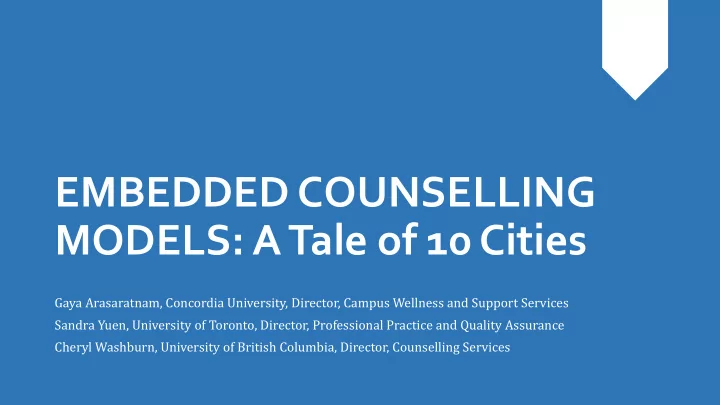

EMBEDDED COUNSELLING MODELS: A Tale of 10 Cities Gaya Arasaratnam, Concordia University, Director, Campus Wellness and Support Services Sandra Yuen, University of Toronto, Director, Professional Practice and Quality Assurance Cheryl Washburn, University of British Columbia, Director, Counselling Services
Presenters Gaya Arasaratnam Director, Campus Wellness & Support Services Concordia University, QC Sandra Yuen Director, Professional Practice & Quality Assurance University of Toronto, ON Cheryl Washburn Director, Counselling Services University of British Columbia, BC
Land Acknowledgement
Outline • Framing our discussions Why study embedded models? Participating universities Learning outcomes of today’s session Project methodology Key findings Common drivers Approaches to service delivery Successes, challenges, key lessons Metrics Q&A
Why study embedded models? Background on embedded models Key drivers for embedded models Overview of different embedded models in North America Tips for developing embedded models
Participating Universities Concordia University QC Dalhousie University NS Memorial University NL University of British Columbia BC University of Calgary AB University of Toronto: St. George ON University of Windsor ON University of Waterloo ON Queen’s University ON Ryerson University ON
Learning Outcomes Background on embedded models Key drivers for embedded models Overview of different embedded models Promising practices
PROJECT METHODOLOGY
Process ANALYSIS DATA OF MODELS COLLECTION Step Step Step Commonalities, Snowball 1 5 3 differences, method. successes, challenges. LITERATURE STAKEHOLDER COMMON REVIEW INTERVIEWS METRICS Step Step Understanding Sharing Creating 2 4 context and structure of KPIs and background. models. metrics.
KEY FINDINGS
Common Drivers Increase accessibility Reduce stigma Enhance awareness & referral Tailor resources to community needs Intervene early to reduce downstream demand. Strengthen Partnerships
Common Services in Hub Intake Walk-In Counselling Hub Services Consultation Navigation Health Outreach Education
Features Where do students access services? What services are provided? Who is served? Who provides services?
Embedded Site as Point of Access 5/10 function as first point of contact for students Offer some combination of triage, single session and/or anonymous drop in sessions. Serve as an access point for students who may find it difficult accessing central service due to time or distance Low barrier access point for students who may not feel comfortable going to central services 5/10: Triage is done centrally, through the Hub. Students are referred to embedded services as appropriate.
Level of Intervention Provided 7/10 : Spokes see a wide variety of cases: low to high risk Tend to replicate many of the services and programs offered in the Hub: Individual counselling, group counselling (2) Wellness programming, workshops (e.g. stress management) Consultation and crisis support 3/10: Spokes see low-moderate severity cases primarily Tend to focus on early intervention, low-mid intensity interventions including: Anonymous drop-in conversations, single session (walk-in & by appt.), brief counselling Psycho-educational workshops (e.g. stress management) & consultation
Single Site vs Neighborhood 2/10 : Serve “ neighbourhoods ” rather than a single faculty Embedded staff may move from site to site as needed and depending on the time of year which helps them build expertise across faculties and reduce faculty reliance on a single counsellor. 8/10: Embedded staff are assigned to a single faculty. Can have a positive effect on capacity building, partnerhships and opportunities for collaboration over time. Faculties tend to provide space/equipment and tend to fund counsellor salaries in full or part.
Multi-Disciplinary Embedded Teams 2/10: Multidisciplinary team approach implementated. Teams may consist of providers from Nursing, Counsellling, Careers, Accessibility, International Student Advising and Chaplains as well as peer support. Students have an opportunity to meet with those who they feel most comfortable approaching. Intentionality of development process varies. Intentional design of embedded model Coordination/integration of existing embedded staff in other disciplines
Successes Students have greater access to resources Increased ability to build student’s mental health literacy Counsellors develop a strong understanding of faculty culture Early intervention Greater support for Faculty Stronger partnerships & opportunities for collaboration Lower costs
Challenges Counsellors can feel isolated and function as “one - person clinics” Maintaining boundaries; working within scope Location and office space can compromise confidentiality and privacy. Program support varies (coordination/supervision, reception/clerical) Faculty drop by needing support with their own concerns Variability in fee structures and inequity between faculties. Some sites may not have funds to support embedded counselling. Leadership changes resulting in loss of program champions
Promising Practices Program Expectations Relationship Management Staff Support Program Evaluation
METRICS
Metrics Perceived value Usage rates Presenting issues and outcomes Embedded therapist experience
Perceived Value Student perception of the value of a faculty-embedded office Partner perception of the value of a faculty-embedded office
Usage Rates Service usage (quantitative) Percentage of on-location services (vs. all mental health services)
Presenting Issues & Outcomes Top 5 presenting issues (student’s self -report) Top 5 presenting issues (clinicians) Learning outcomes Client satisfaction Pre- post treatment outcome
Embedded Therapist Experience How supported they feel being away from the main centre How much they experience “mission creep” - being asked to do more than the role is defined to do
THANK YOU gaya.arasan@concordia.ca sandra.yuen@utoronto.ca cheryl.washburn@ubc.ca
Recommend
More recommend